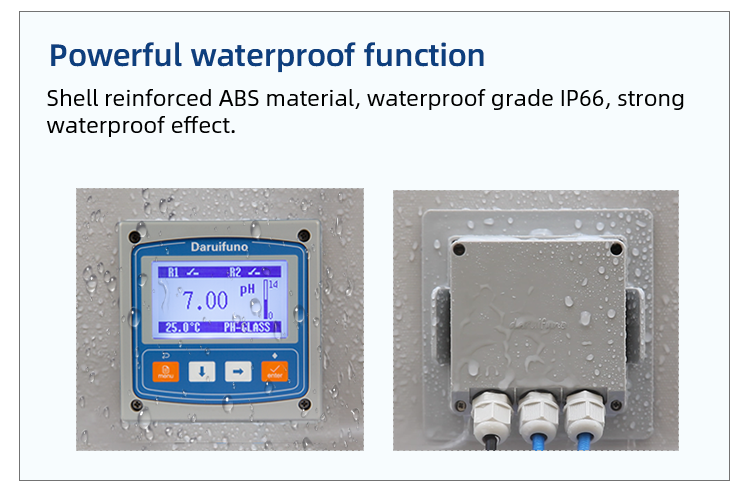Suzhou Delfino Environmental Technology Co., Ltd. |
|
Verified Suppliers
|
|
Online PH/ ORP Controller with RS485 Two Relays One 0/4~20mA Output For Sewage Or Drinking Water
pH transmitter APX1-C1Z is an instrument used to measure and monitor the acid-base properties (pH value) of a solution and is commonly used in chemistry, biology, pharmaceuticals, food processing, environmental monitoring and other fields. The main functions and functions of pH transmitter include:
pH value measurement: The pH transmitter can accurately measure the pH value of the solution. This value represents the acidic and alkaline properties of the solution, usually expressed in the range of 0 to 14, where 7 means neutral, lower than 7 means acidic, and higher than 7 means acidic. 7 means alkaline.
Real-time monitoring: The pH transmitter can continuously monitor the pH value of the solution and transmit the data to the monitoring system or operator in real-time or periodic manner. This allows users to understand the pH changes of the solution in a timely manner.
Controlling the process: pH transmitters are often integrated with control systems and are used to automatically adjust the process of adding acid or alkaline substances to maintain the pH of the solution within a specific target range. This is particularly important in industrial production and chemical processes.
Quality Control: In food processing, pharmaceuticals, and other industrial processes, pH transmitters are used to ensure product quality and consistency, as pH can affect product taste, safety, and stability.
Environmental monitoring: pH transmitters are also used to monitor the pH value of water bodies in natural water bodies, wastewater treatment and environmental protection projects. This is important to protect ecosystems and ensure the sustainability of water bodies.
Alarm function: The pH transmitter has two relays. The relay of the instrument can be used to control the external buzzer to achieve the alarm function. When it detects that the pH value exceeds the predetermined range, it can sound an alarm so that timely measures can be taken to avoid potential problems or dangers.
In short, the function and role of the pH transmitter is to measure, monitor and control the pH value of the solution to ensure the quality, safety and stability of the production process, and is also used for environmental monitoring and protection. These devices have a wide range of applications in a variety of industries.
Specification:
| Model | APX1-C1 | APX1-C1Z | |
| Principle | PH | Glass pH electrode (hydrogen ion concentration index) | |
| ORP | Platinum or gold electrodes (redox potential) | ||
| Display Range | PH | 0~14pH | |
| ORP | ± 2000mV | ||
| Temp | -10~150℃ | ||
| Resolution | PH: 0.01pH ORP: 1mV TEMP: 0.1℃ | ||
| Accuracy | 0.1% of the measuring range or ±0.02pH / ±2mV, take the larger one | ||
| Stability | 0.05% of measuring range every 24 hours without accumulation | ||
| Repeatability | Better than 0.1% of measuring range | ||
| Temp Compensation | Automatic or manual (NTC10K/PT1000) | ||
| Relay Output | Two SPST relays, Max. load 3A/250VAC, set high/low alarm, temp or clean control | ||
| Digital Communication | —— | A two-wire RS485 interface, Modbus RTU | |
| Current Output | A 0/4~20mA current Max. load 1000Ω | ||
| Language | English | ||
| Display | 128*64 3.2-inch graphic dot matrix LCD | ||
| Calibration Method | PH: 3 points ORP: 2 points | ||
| Protection Grade | IP66 | ||
| Enclosure Material | Enhanced ABS | ||
| Power Supply | AC: 100~240V 50/60Hz or DC:18~36V, | ||
| Dimension | 100*100*120mm (Hole size 92*92mm) | ||
| Electrical Interface | Reserve three M12*1.5 glan heads, the wire diameter is 3~6.5mm | ||
| Work Temperature | 0~60℃, RH<95%, non-condensing | ||
| Storage Temperature | -20~70℃, RH<55%, non-condensing | ||
| Installation | Panel | ||
| Weight | 450g | ||
| Power Consumption | Max. 3W | ||


Brief introduction:
Two SPST relays to set high and low alarms and control dosing
A 0/4~20mA current Max. load 1000Ω
The use environment includes but not limited to the following:
Laboratory environment:
pH and ORP sensors are commonly used in laboratories for chemical
analysis, biological experiments and research applications. These
environments are often tightly controlled to ensure high precision
and accuracy.
Industrial production:
Chemical plants, pharmaceutical plants, food processing plants, and
other industrial sites use pH and ORP sensors to monitor and
control production processes. This helps ensure product quality,
increase production efficiency and avoid unnecessary waste.
Environmental monitoring:
pH and ORP sensors are widely used in the field of environmental
monitoring to detect and monitor the properties of water, soil,
wastewater and pollutants. This helps protect the natural
environment and human health.
Water treatment:
Drinking water treatment plants and wastewater treatment plants use
pH and ORP sensors to monitor and regulate the pH and redox
properties of water to ensure water quality is up to standard.
Pool and Spa:
pH sensors are used to monitor the pH level of swimming pool and
spa water to maintain clean and safe water.
Agriculture:
The field of agriculture uses pH sensors to monitor the pH of the
soil to determine the most suitable soil conditions for growing
different crops.
Food and drinks:
The food and beverage processing industry uses pH sensors to
monitor and regulate the pH of food products to ensure product
safety and taste.
Aquarium:
pH and ORP sensors are used to monitor the quality of water in fish
tanks, aquariums and aquarium exhibits to ensure the health of fish
and aquatic life.
It should be noted that different applications may have different
requirements for sensor accuracy, durability and environmental
conditions. Therefore, when choosing pH and ORP sensors, you must
consider the characteristics of the use environment and choose a
suitable sensor model to ensure accurate and reliable measurement.